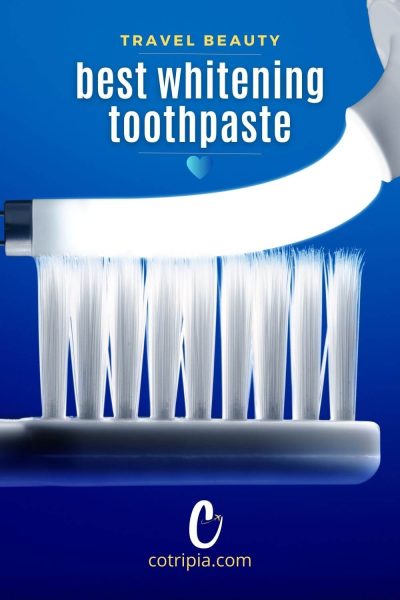A dazzling, white smile is not just a sign of good oral health; it’s a confidence booster that lights up your face. In the quest for a brighter, whiter smile, many turn to whitening toothpaste as a convenient and accessible solution. In this comprehensive guide, we’ll explore the best whitening toothpaste options, uncovering the key ingredients, benefits, and best options to help you achieve that radiant smile you’ve always desired.

1. Understanding Teeth Whitening Toothpaste:
How It Works: Whitening toothpaste typically contains mild abrasives and special chemical agents that help remove surface stains from teeth. Some also include ingredients to prevent new stains from forming.
Types of Stains: Whitening toothpaste is effective against extrinsic stains caused by surface-level factors like coffee, tea, or smoking. Intrinsic stains, which result from deeper issues, may require professional treatments.

2. Key Ingredients in Whitening Toothpaste:
Hydrogen Peroxide: A common whitening agent that helps break down and remove stains from the surface of teeth.
Baking Soda: Acts as a mild abrasive to help scrub away surface stains and polish teeth.
Activated Charcoal: Known for its adsorbent properties, it binds to stains and toxins, helping to lift them from the teeth.
Potassium Nitrate: Helps reduce tooth sensitivity, a common concern with whitening products.

3. Best Whitening Toothpaste Options:
Crest 3D White Brilliance Toothpaste: Known for its advanced stain protection, this toothpaste combines a fluoride formula with micro-cleansing agents for a radiant smile.
Colgate Optic White Express White Toothpaste: With hydrogen peroxide as a key ingredient, this toothpaste is designed to deliver fast and effective whitening results.
Arm & Hammer Advance White Toothpaste: Featuring baking soda as a primary ingredient, it helps to gently polish and whiten teeth while neutralizing plaque acids.
Sensodyne Pronamel Gentle Whitening Toothpaste: Ideal for those with sensitive teeth, this toothpaste not only whitens but also strengthens enamel, providing a dual benefit.
Opalescence Whitening Toothpaste: Contains a unique blend of ingredients, including fluoride and potassium nitrate, for effective whitening and enamel protection.
4. Tips for Using Whitening Toothpaste Effectively:
Consistent Use: Whitening toothpaste is most effective with consistent use. Brush twice a day for at least two minutes for optimal results.
Watch for Sensitivity: If you experience tooth sensitivity, consider using a toothpaste designed for sensitive teeth or reducing the frequency of whitening toothpaste use.
Pair with Good Oral Hygiene: Whitening toothpaste complements a good oral hygiene routine. Combine it with regular flossing, mouthwash, and professional cleanings for comprehensive dental care.

5. Addressing Common Concerns:
Tooth Sensitivity: Some individuals may experience temporary tooth sensitivity with whitening toothpaste. If this occurs, consider using a toothpaste designed for sensitive teeth.
Long-Term Results: Whitening toothpaste provides gradual results and is effective for maintaining a bright smile. However, for more immediate and dramatic results, professional teeth whitening may be considered.
6. Conclusion
Choosing the best whitening toothpaste is a step towards achieving a brighter, more radiant smile. Whether you opt for a hydrogen peroxide-based formula or one with baking soda, consistency is key. With a commitment to good oral hygiene and the right toothpaste, you can confidently showcase your beautiful, pearly whites to the world. Embrace the journey to a brighter tomorrow, one smile at a time.

7. Frequently Asked Questions (FAQs)
1. How does whitening toothpaste work?
- Whitening toothpaste typically contains mild abrasives and whitening agents that help remove surface stains from teeth. Some formulations may also include ingredients to prevent new stains from forming.
2. Can whitening toothpaste remove intrinsic stains?
- Whitening toothpaste is most effective against extrinsic stains on the surface of teeth. Intrinsic stains, which originate from deeper issues, may require professional treatments for effective removal.
3. Are there different types of whitening agents in toothpaste?
- Yes, common whitening agents in toothpaste include hydrogen peroxide, baking soda, activated charcoal, and potassium nitrate. These ingredients work to break down and remove stains from the teeth.
4. How often should I use whitening toothpaste?
- It is generally recommended to brush your teeth with whitening toothpaste twice a day for at least two minutes each time. Consistent use is key to achieving optimal results.
5. Can whitening toothpaste cause tooth sensitivity?
- Some individuals may experience temporary tooth sensitivity with whitening toothpaste. If sensitivity occurs, consider using a toothpaste designed for sensitive teeth or reducing the frequency of whitening toothpaste use.
6. How long does it take to see results with whitening toothpaste?
- Whitening toothpaste provides gradual results over time. While individual experiences may vary, noticeable improvements in tooth color can typically be observed after several weeks of consistent use.
7. Are there specific tips for using whitening toothpaste effectively?
- Consistent use is essential for effective results. Brush for at least two minutes, and be mindful of tooth sensitivity. Pairing whitening toothpaste with good oral hygiene practices enhances overall dental care.
8. Can I use whitening toothpaste with other teeth-whitening products?
- Yes, you can use whitening toothpaste in conjunction with other teeth-whitening products. However, it’s advisable to follow the instructions provided with each product to ensure safe and effective use.
9. Do all whitening toothpaste options contain fluoride?
- Not all whitening toothpaste options may contain fluoride. However, many reputable brands include fluoride in their formulations to strengthen enamel and provide additional oral health benefits.
10. How long do the whitening effects of toothpaste last?
- The longevity of whitening effects can vary based on factors such as diet, oral hygiene habits, and lifestyle. Regular maintenance with whitening toothpaste helps sustain a brighter smile over time.
11. Can whitening toothpaste replace professional teeth-whitening treatments?
While whitening toothpaste is effective for maintaining and enhancing the whiteness of teeth, professional teeth-whitening treatments may offer more immediate and dramatic results for significant color changes.
Recommended for You
Embarking on a journey to explore the world is a...
In a world brimming with astonishing landscapes, diverse cultures, and...
Venturing into the great outdoors on a hiking adventure requires...
As the festive season approaches, the allure of a Christmas...
Author

Cotripia is your gateway to elevated travel. We serve as your portal to the world of stylish travel, exquisite beauty products, luggage, and all the vital travel essentials. Furthermore, we provide an array of valuable resources, including expertly crafted packing guides, meticulous checklists, insider tips, enlightening ebooks, and much more.
View all posts






